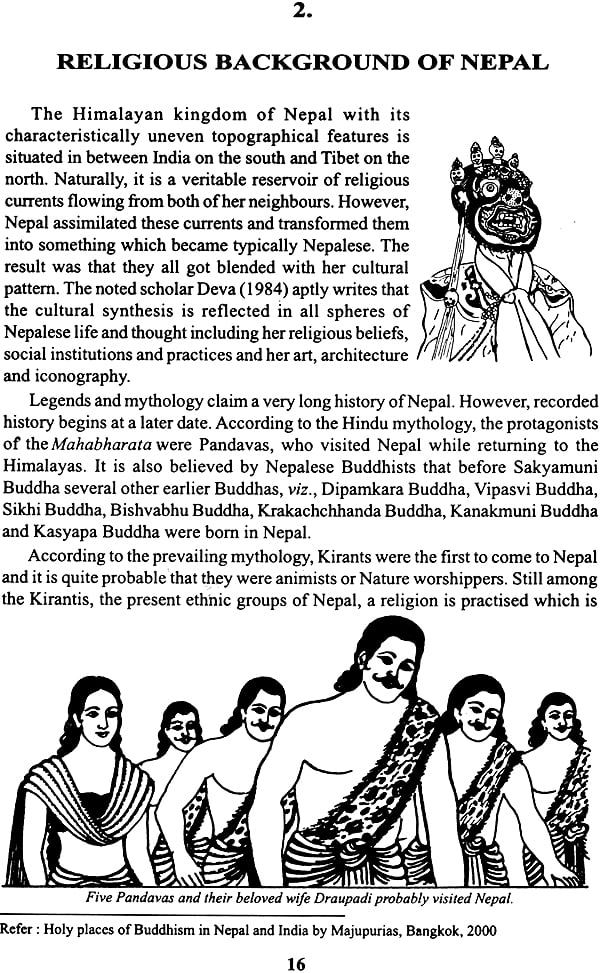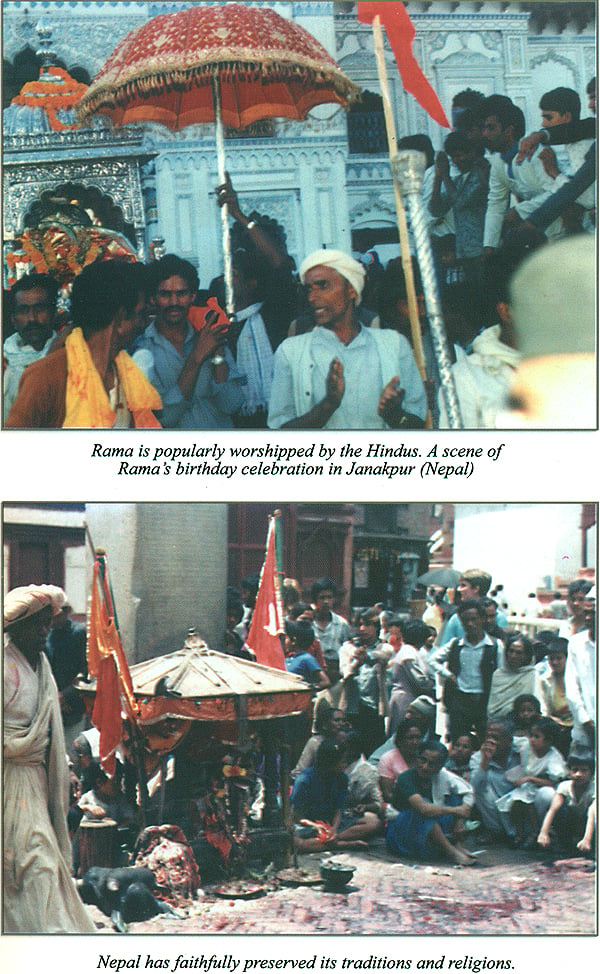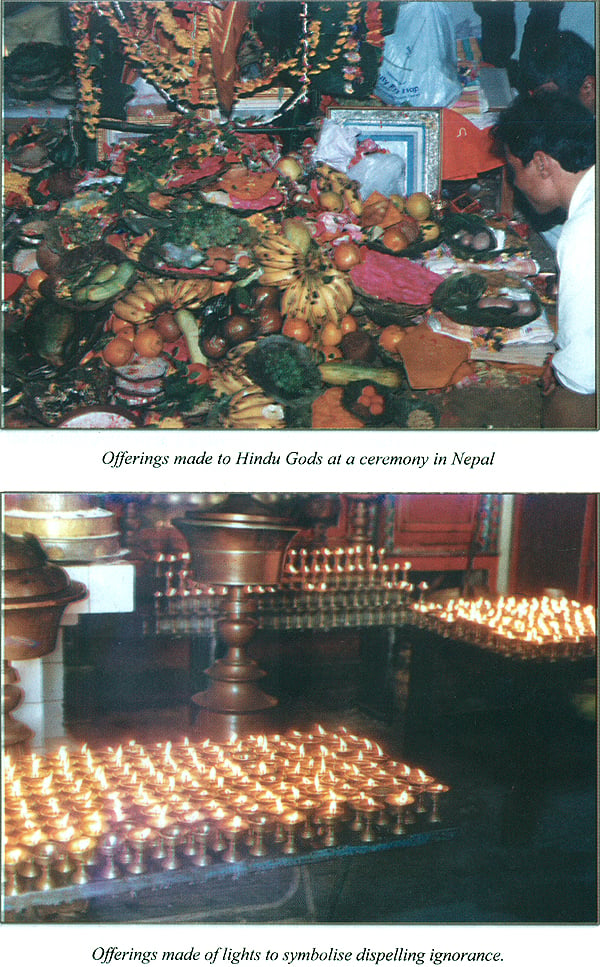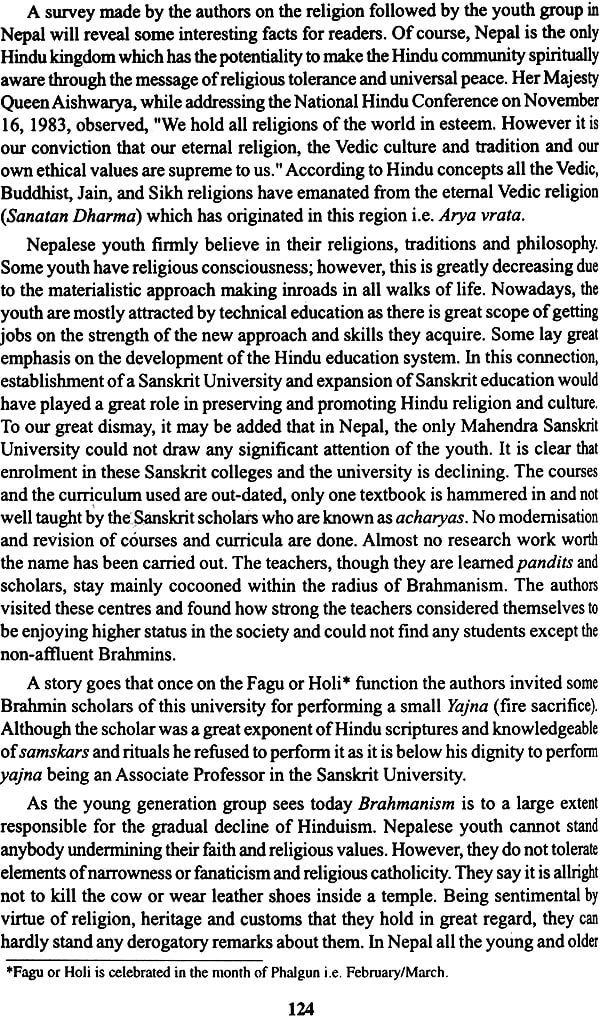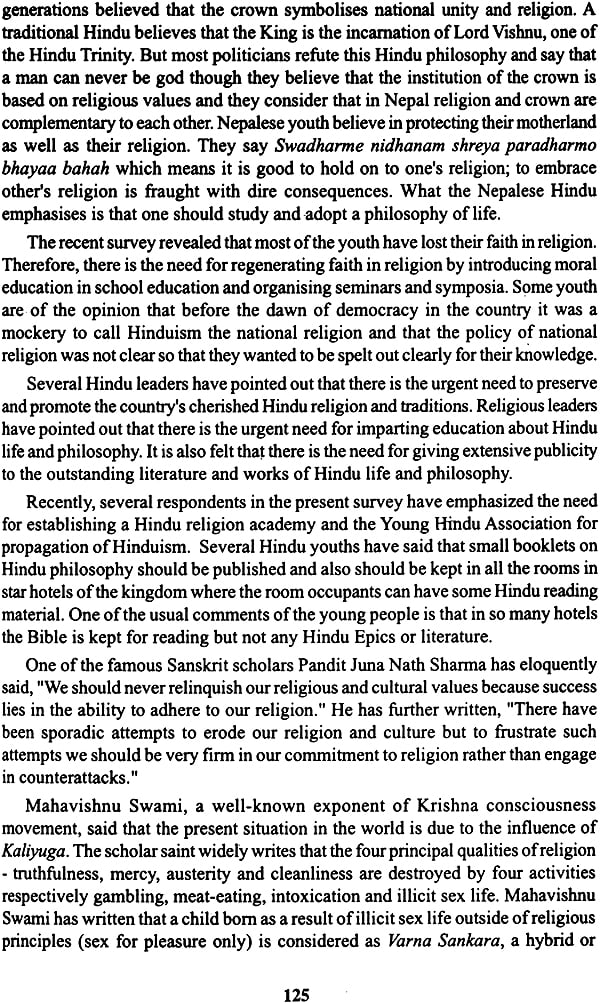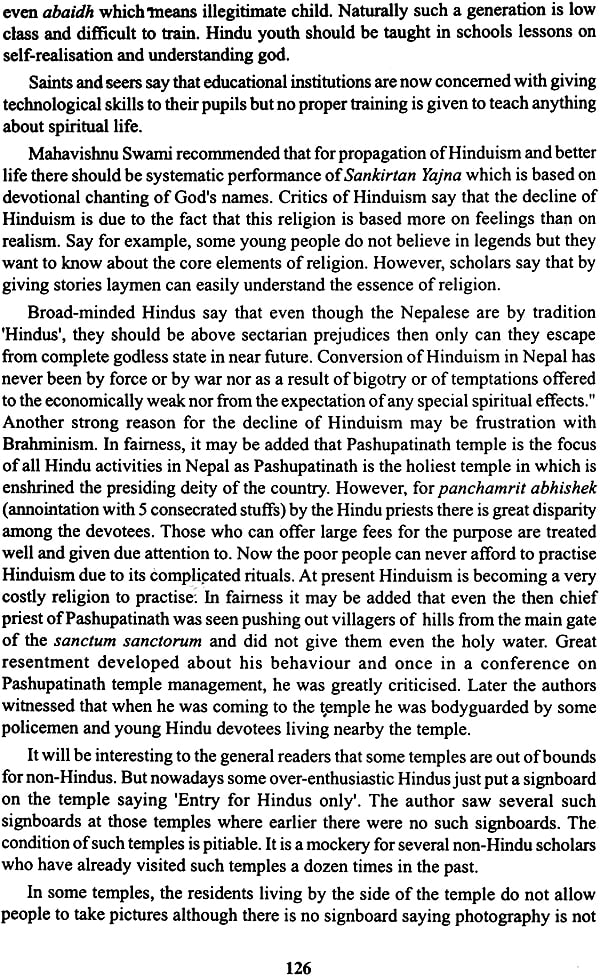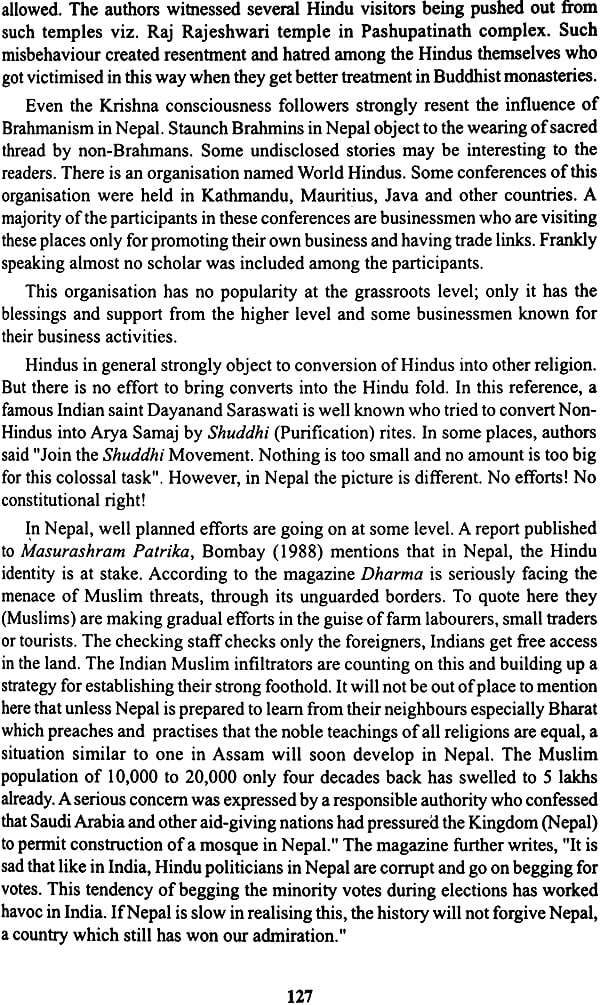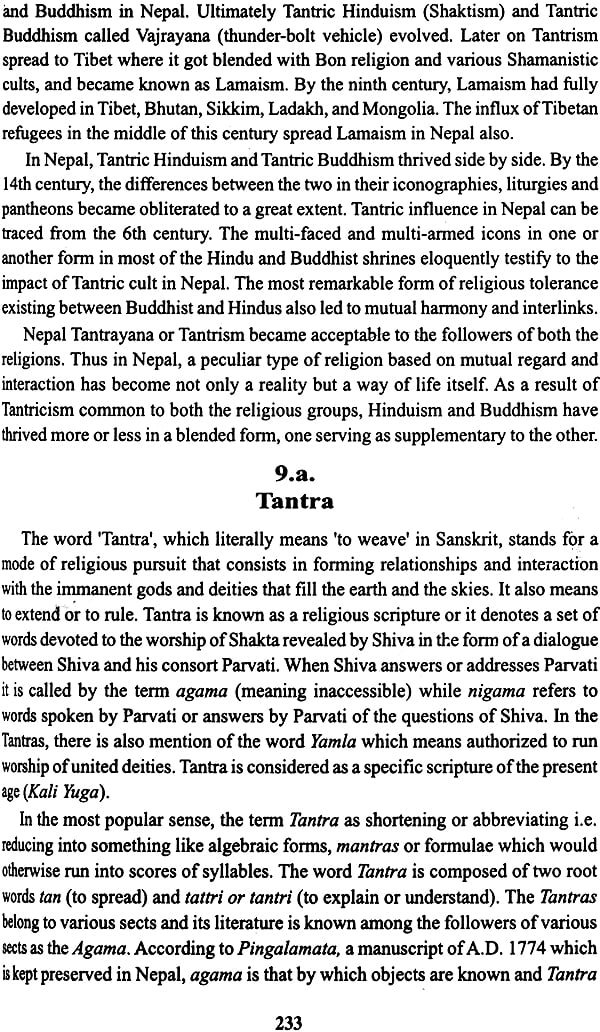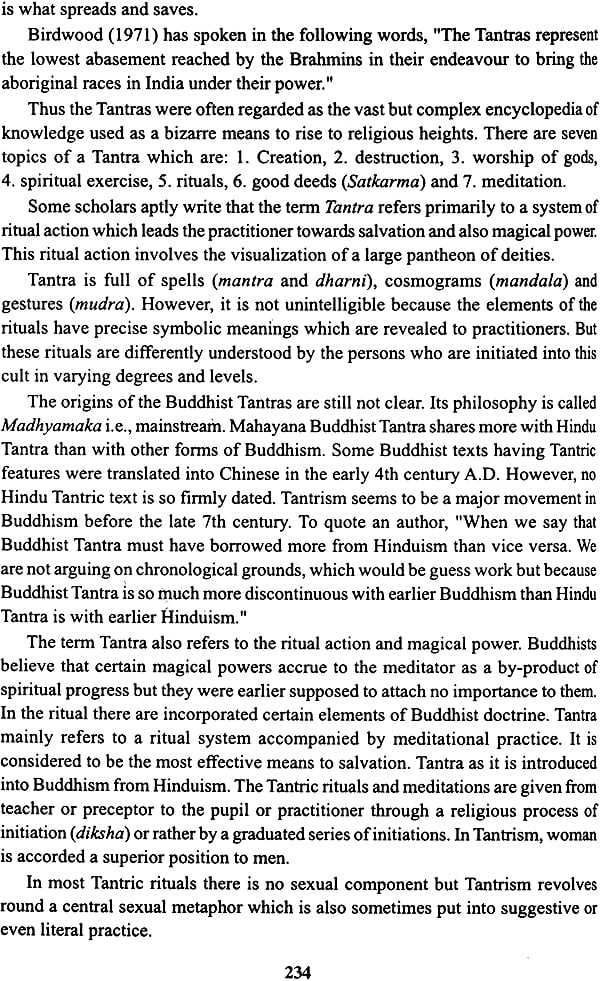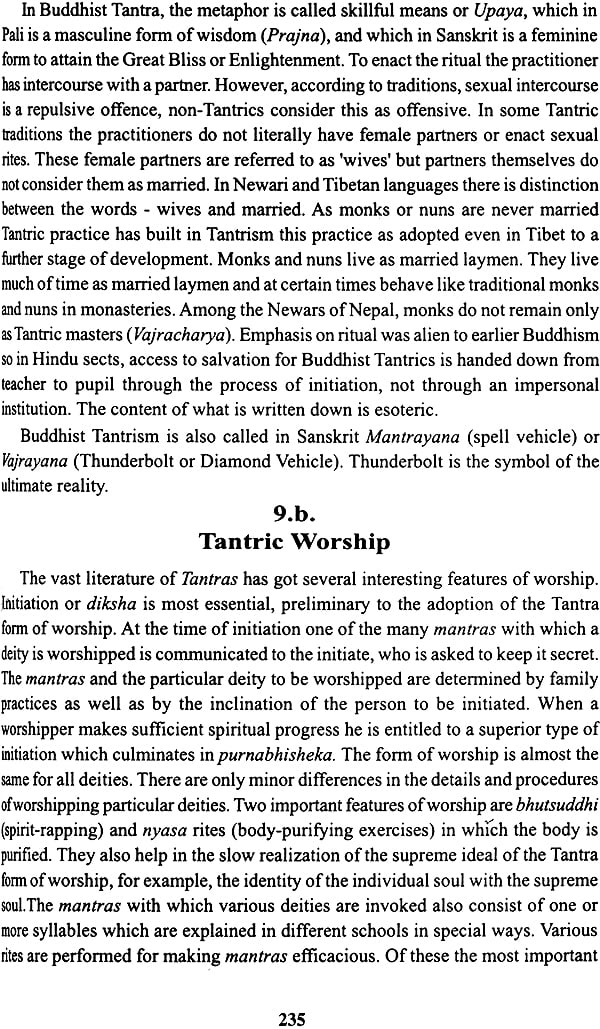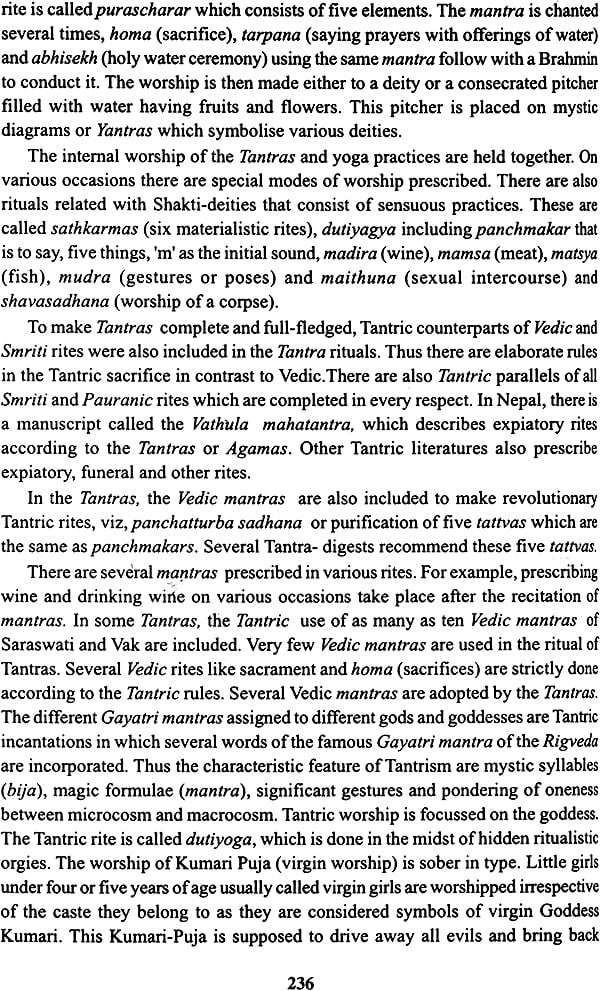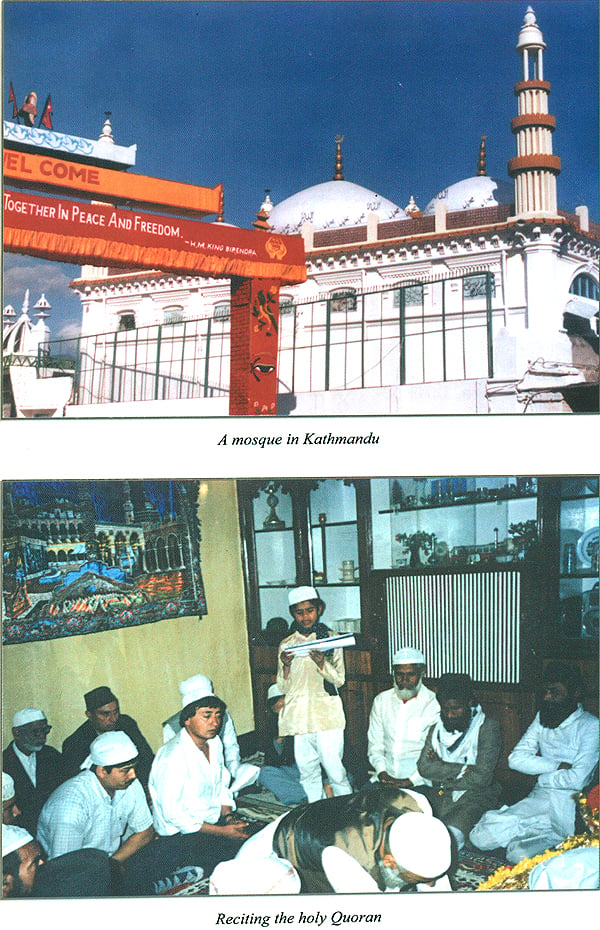
Religions in Nepal (With Reference to Religions of Tibet and India)
Book Specification
| Item Code: | NAM661 |
| Author: | Trilok Chandra Majupuria |
| Publisher: | Majupuria |
| Language: | English |
| Edition: | 2008 |
| ISBN: | 9789993330561 |
| Pages: | 402 (Throughout B/W and Color Illustrations) |
| Cover: | Paperback |
| Other Details | 9.0 inch x 6.0 inch |
| Weight | 580 gm |
Book Description
Trilok Chandra Majupuria, M.Sc., Ph.D, D.Sc. Formerly Senior scientist in Newyork and Professor of Zoology, Tribhuvan University Kathmandu Nepal. He has been teaching for 50 years and guiding Ph.D. and D.Sc. students for last several years. He has written several books on Nepal, the notable ones being: Sacred and Useful Plants and Trees of Nepal, Nepal: The Land of Festivals, Marriage Customs of Nepal, Youth of Nepal, Glimpses of Nepal, Peerless Nepal, Pashupatinath, Complete Guide to Nepal, etc. Two most scholarly books he has authored and edited on natural history of Nepal are: Wild is Beautiful, Introduction to wildlife, and fauna of Nepal. The other book is Nepal-Nature's Paradise, which gives an insight into diverse facts of the country's topography, flora and ecology. He has edited some scholarly and informative books: Wildlife Wealth of India, Butterflies of Nepal, Magnificent Nepal Himalaya. He has got a wide interest in various fields. His interest in culture was sparked off by the original studies he carried out on the Sacred and Symbolic animals of Hinduism and Buddhism for about 50 years. He has been on a lecture tour to several universities in different countries. Prof. Majupuria has been honoured by several social and educational organizations.
The meaning of 'Religion' has been given in several ways. Etymologically, the word 'religion' comes from Latin source religare meaning being bound or religere meaning from together. Though this meaning is in some homilectical sense suffers from inadequacy.
Religion also means belief in or recognition or an awakened sense of, higher unseen controlling power or powers, with the emotion and morality connected therewith: rites or worship, any system of such belief or worship, devoted fidelity, monastic life, etc. The term religion is also conceived as having reference to certain characteristic types of beliefs, practices, feelings, moods, attitudes, etc. There is no absolute difference between religion and morality. Different people draw the line at different points. It is aptly said that man in course of his mental or psychic growth gets the conception of religion and slowly begins to distinguish between what is and what is not religion. To find the distinction between religious and non-religious involves not only various beliefs and practices but also mental or psychic aspects of all individuals concerned. Individuals, as a result of certain vicissitudes in their development, have the beliefs which are called religious or who again as a result of their experience differentiate between what is religious, non-religious and anti-religious.
Tylor (1871) defines religion in a simple way as 'belief in spiritual beings'. This belief arises from the imagined nature of these beings, and is roofed in its validity for every individual.
Duckheim (1915) defines religion as follows, "A religion is a unified system of beliefs and practices relative to sacred things, that is to say things that set apart for bidden beliefs and practices, and which unite all those who adhere to them into one single moral community."
Galloway (1914) suggests that religion is man's faith in a power beyond himself whereby he seeks to satisfy his emotional need and to gain stability in life for which he engages himself in the act of worship and service. Caird (1804) writes that 'A man's religion is that consciousness in which he takes up a definite attitude towards the world and on which he focuses all the meanings of his life".
In this context, some significant terms like, sacred, supernatural, death, heaven, etc. require definition and elaboration. When pursued logically the ideas ultimately concern man's whole body of thought, both religious and non-religious. Religion also means belief in and worship of the god or the almighty. To some, religion is human recognition of superhuman controlling power, especially of a personal god. Some people also think that religion is a mental attitude and a state of mind. Webb (1916) asserts on the other hand that religion cannot be defined. Hindus call their religion dharma in Sanskrit, which means righteousness that underlies the law.
Swami Vivekananda has very emphatically defined religion as follows, 'Religion is not in doctrines or in dogmas, not in intellectual argumentation, it is being and becoming, it is realization.'
In Buddhism, Dharma (Dhamma- in Pali) is the word used for religion and it means wisdom or knowledge or righteousness. Therefore, the first teachings of Buddha are called Dhammachakra parvattna (Dhammachakkapavattna - in Pali).
At times men have been forced to reconsider current and inherited beliefs and ideas to gain some harmony between present and past experiences so as to reach a position which can satisfy the demands of feelings and reflexions and can give confidence for facing the future. At present religion has been a subject of critical and scientific inquiry. Both practical and theoretical significance has attracted increasing attention. Religion has been subjected to inquiry by some factors which are as follows: (a) rapid progress of scientific knowledge and thought; (b) the deeper intellectual interest in the subject; (c) the tendencies to reform or reconstruct religion or even replace it by some body of thought, more rational and scientific and less superstitious; and (d) the effect of social, political and international events. Some of which in the past have both influenced and been influenced by religion. In pertinent reference to Nepal the last factor is most significant. After the dawn of democracy in 1950, religious activities or conditions have greatly affected the social order in the country and the value of religion has been greatly involved. In Nepal, religion is a way of life. It is something more than a practice of sacred rites or a mere tradition.
Religion is a very sensitive topic. Therefore, here only broader outlines have been dealt with and any controversial point of comparison has been avoided. The very nature of the subject forbids anyone-sided treatment. Neither one particular aspect can form the basis nor can it be ignored. There is no other subject of human knowledge where there are differences of opinion so acute. There is also a great risk of causing offence in dealing with the subject of religion. It also inevitably involves both the non-religious or secular and the anti-religious or irreligious blasphemous points. Therefore, a restrained and impartial treatment is demanded but impartiality and objectivity are also regarded as irreligious.
Hastings (1955) aptly writes as follows, "None the less the acute problems are such that if any critical or scientific treatment is once legitimate it must be pursued as thoroughly as possible with the consideration for the convictions of others that one would ask for one's own and with the clearest recognition of the fact that the subject concerns the most vital beliefs and practices of human beings, all of whom may, on purely scientific grounds, be regarded as closely related-physiologically and psychologically."
There are various religions in vogue in various parts of the world. However, religions are for understanding. Only fanatics, fundamentalists and orthodox people argue uncompromisingly for their religions. Even several persons do not know about their own religious philosophies, texts, etc. and they are completely ignorant about other religions. The authors believe that this ignorance is the cause of all religious conflicts. It is aptly said that religion is for humanity at large and for love of all human beings. No hatred.
This book is intended just to introduce the religions as practised in Nepal, with special reference to their philosophies, rites, rituals, etc. The tendency among the authors to deal critically and quite freely with the religions which are not their own is also avoided. To avoid any difference of opinion the chapters have been critically revised and reviewed by the adamant followers of that particular religion. Reviewers of different chapters are duly acknowledged in each chapter.
We hope it will be useful to the general visitors who visit Nepal. Many visitors have a desire to know the history and religion of Nepal and this book will satisfy their thirst or inquisitiveness about religions in Nepal. Believers of all faiths live in Nepal in harmony with each other except some sporadic cases of quarrels or arguments over religion. This may be due to the fact that no Nepalese follow a strictly particular cult or religion. Sometimes politicians playa crucial role.
Hinduism is the oldest living religion in the world. It is unique in its tolerance of other religions. It also offers different spiritual paths to persons of different aptitudes. However, it emphasises on individual spiritual experience. In view of free thinking and for lack of strictness and compulsion, Hindus know very little of their religion.
The Bhagvad Gita also teaches the spirit of universal tolerance and reiterates the view that every form of religious worship is a stepping-stone towards a higher form and therefore, should be respected. The different forms of worship are like different roads which lead to the same destination.
In this book religions of Nepal have also been dealt with in the context of the religious practices of India and Tibet as the cultural intercourse with these neighbours played a considerable role in the evolution and development of religions in Nepal. The authors also wrote a book 'Gods and Goddesses in Nepal' in which they gave an illustrated account of Hindu, Buddhist, Tantric, Hybrid and Tibetan deities. To understand various pantheons, it is also essential to understand various religions. Therefore, the authors ventured to write this book for giving basic ideas of various religions practised in Nepal hoping it will be an exciting adventure. Minute details about religions are avoided as they may bore the general readers rather than interest them.
There may be repetition of the same thing in a few places. But this has been done to make each chapter fully and explicitly readable. On the whole, the book has been written in a simple style; it is pleasantly readable and is free from abstruse ideas. It is also profusely illustrated.
The authors have faith in all religions whereas practising a religion of their choice is a different story. Several times they arranged public sermons of Hindus, Buddhists, Jains, etc. or participated in religious activities and masses of Sikhs and Christians. They went to mosques in several Muslim countries. Once the senior author had an opportunity to fly over the mosques of Mecca and Madina during the annual fair (Haj). However, he could not land as non-Muslims are not allowed entry in these Muslim places of pilgrimage. The authors visited many Gurudwaras (Sikh temples). The senior author also visited Vatican Church in Italy besides Catholic and Protestant churches of other countries. Sometimes the authors have been warned by fanatics that they should stick to one religion and should not talk of other religions. The authors considered it a mockery. The authors also met several famous saints and seers. Thus this book is an outcome of their wide research and survey in various places and countries where these religions are practised. A glossary is also added which explains some of the popular words.
In writing this book, the authors have been fair in dealing with all religions equally owing to the authors having good background and acquaintance with various religions and their taking care to follow a non-conservative positive approach.
However, in fairness it may be said that they could not get any support for this publication as they think that people are materialistic and are not quite religious- minded. But when their own religion is involved they become fanatics. We have further observed that a majority of the so-called staunch religious-minded persons are not at all well-read or they have not thoroughly read and strictly followed their own religious texts.
In the process of writing this book the authors are obliged to Mr. Gaja Sundar Pradhan for editorial services and Mr. Shambhu Shah for line-drawings. The authors are also obliged to Mrs. Indra Majupuria for various suggestions and for all the privations she had to contend with in order to lend assistance to us in our task of writing this book.
We hope this book will be useful, informative and interesting. Any suggestions for improvement or corrections are most welcome.
In Nepal, all major religions are not only practised or followed but they are promoted simultaneously in perfect harmony. Religious strife and intolerance have been almost unknown in the history of Nepal. However, history mentions that Shankaracharya, a Hindu exponent from India, visited Nepal and urged the people to boost and spread Hinduism in a big way. In those days he saw that in Nepal Buddhism was in a more prosperous stage.
According to the statistical data of 1981, there were about 89.5 percent Hindus and Buddhists were about 5.3 percent. In fact, Hindus include Buddhists, Jains and Sikhs in their fold in Nepal. These along with different sects of Hinduism live in complete religious hatmony. Hindus in Nepal believe that Hinduism virtually denotes every type of religious belief and cult that originated in the land of Indian subcontinent (South Asia) and they describe Hinduism as Sanatan Dharma (Eternal righteousness ).
However, Buddhists strongly believe that their number is much higher in Nepal than the figures given by Central Bureau of Statistics, Nepal. They have the feeling that they are very much dominated by the Brahmins of Nepal. The detailed percentage of population by religion and sex for Nepal, 1981 as given by Central Bureau of Statistics is as follows:
| Religion | Total number | Percentage |
| Hindus | 13445787 | 89.5 |
| Buddhists | 799081 | 5.3 |
| Muslims | 399197 | 2.7 |
| Jains | 9438 | 0.1 |
| Christians and others | 369336 | 2.4 |
The details of the Census as given in 1991 by religion are as follows: Total Population 18,451,097.
| Religion | Total number | Percentage |
| Hindus | 1,59,96,953 | 86.5 |
| Buddhists | 15,16,703 | 8.2 |
| Muslims | 653218 | 2.83 |
| Jains | 7561 | 0.038 |
| Christians | 31280 | 0.168 |
| Kirantis | 318389 | 1.72 |
| Others | 26416 | 0.14 |
| Not stated | 18138 | 0.1 |
| = 99,196 |
The details of the census of 2001 by religion available in Apirl 2002. Total population is 22736934.
| Religion | Total number | Percentage |
| Hindus | 18330124 | 80.62 |
| Bouddha | 2442520 | 10.74 |
| Islam | 954023 | 4.2 |
| Kirat | 818106 | 3.6 |
| Jain | 4108 | 0.02 |
| Christian | 101976 | 0.45 |
| Sikh | 5890 | 0.03 |
| Bahai | 1211 | 0.01 |
| Others | 78979 | 0.35 |
The data of Kirant or Kirat was not taken into consideration in 1981 census. In 1991 census the data under new head of Kirantis or Kirat is 1.72 91991). It increased to 3.60 (2001). Kirantis are followers of animism, a religion something different from Hinduism and Buddhism.
Christians have increased from 0.168 (1991) to 0.45 (2001). In 1981 data of Christians were included in others.
Sikhs were not enumerated in 1991. In 2001, their percentage is 0.03. Another religion, Bahaism has also appeared in data of 2001. Their percentage is 0.01. Bahais are adherents of a religion originated in Iran in the 19th century. It emphasises spiritual unity of mankind.
Some scholars say that there are some conflicting remarks about the percentage of the population of followers of some religions and the figures given are not reliable.
There are about 22 major languages spoken in Nepal. These are Nepali, Maithili, Bhojpuri, Tharu, Tamang, Newari, Awadhi, Rai-Kiranti, Limbu-Magar, Gurung, Limbu, Rajbanshi, Satar, Dunwar, Bhotia-Sherpa, Sunawar, Santhal, Thakali, Urdu, etc. (Some Scholars say that there are 56 dialects in Nepal).
Nepal is the only Hindu country in the world. The new constitution of the Kingdom of Nepal 1990 states, "The Kingdom of Nepal is a multi-ethnic, multilingual, democratic, independent, indivisible, sovereign Hindu and constitutional monarchial Kingdom." Before the promulgation of the new constitution, there was a nationwide movement to make the Kingdom of Nepal a secular state. There were several protests, processions and conferences to press the demand for secularism. However, for maintaining the status quo, Nepal was declared a Hindu country.
According to the constitution (1990) Part 3 Fundamental Rights. (1) Right to Equality- All citizens shall be equal before law. No person shall be denied equal protection by the laws. (2) No discrimination shall be made against any citizen in the application of general laws on the grounds of religion, race, sex, caste, tribe or ideology or any of them.
However, in Nepal change of religion is not permitted. According to the Fundamental Rights mentioned in Part 3 of the constitution of the Kingdom of Nepal (1990), Clause 19, Right to religion is mentioned as follows: (l)Any person shall have the freedom to profess and practise his own religion as coming down to him from time immemorial with regard to the traditional customs, but no person shall be entitled to convert the religion of any other person. (2) Any religious community shall be entitled to its independent existence according to law and shall have the right to manage and protect its religious places and trusts."
Some consider it queer as Buddha, the propounder of Buddhism, was born as a Vedic child with Vedic rites and rituals.
Though constitutionally the religion of the country is Hinduism, there is always religious tolerance. Hiuen Tsang, a Chinese pilgrim who came to Nepal in 616 A.D., also mentioned that there was perfect harmony in the matter of religion. There has been a long interaction between the Hindus and Buddhists as a result of which a synthesised religion evolved.
Deva (1984) writes that about 1500 years ago, a majority of the Nepalese were followers of Buddhism which was then the religion of the country. But the Hindu immigrants in various periods have influenced the Nepalese way of life and there is Hinduism while in the middle or the valley region or the greater part of the country both Hinduism and Buddhism are in existence, especially in an intermixed form. In other words, both Hinduism and Buddhism exist in the same place, in the same temple, in the minds and hearts of the people and their rituals and ceremonies. In the philosophies of both the religions several practices have come to stay. There is thus a kind of syncretism between Hinduism and Buddhism as they exist in Nepal.
Exponents of both Hinduism and Buddhism admitted that the two streams of the same river can never come into conflict with one another but they would exist side by side in peace and in harmony. These religions existed side by side as their basic principles consisted in tolerance for every human being and in kindness to animals. Hinduism, as it stands in Nepal, is that as practised in India with the addition of some Buddhist customs, rituals, festivals and deities. Theravada Buddhism as well as Vajrayana form which is an off-shoot of Mahayana, is followed by a majority of Nepalese Buddhists, which also includes several Hindu legends, rites, rituals and deities. Vajrayana is different from Mahayana in that it lays emphasis on Tantric religious symbolism. However, they do not differ in their basic features.
Shaktism or Tantrism is adopted by both Hindus and Buddhists. Besides, there are other religions viz., Lamaism and Bon religions which are practised by those ethnic groups who live in high mountains of Nepal and are Tibetan in origin. Some other inhabitants of Nepal are followers of Jainism, Sikhism, Islam and Christianity.
The religions of Nepal can be dealt with under the following heads:
| a | Animism | |
| b | Hinduism | |
| c | Buddhism | |
| 1 | Theravada | |
| 2 | Mahayana | |
| d | Vajrayana | |
| e | Tantrism (Shaktism) | |
| f | Syncretism of Hinduism and Buddhism | |
| g | Bon | |
| h | Lamaism | |
| i | Jhankrism | |
| j | Jainism | |
| k | Sikhism | |
| l | Islam | |
| m | Christianity |
(Some Nepalese scholars include Jainism and Sikhism in Eternal Hindu, religion known as Sanatan Dharma).
| Preface | 6 | |
| 1 | Introduction | 11 |
| 2 | Religious Background of Nepal | 16 |
| 3 | Inter- influence of various Religious in Nepal | 24-26 |
| 4 | Animism | 32 |
| 5 | Hinduism | 44-130 |
| a | Hindus and Hinduism | 45 |
| b | Various Sects of Hindus (Vaishnavas, Shaivas, Shaktas, Ganapatyas, Saurapatha, Smarthas) | 48 |
| c | Basic Principles of Hinduism | 66 |
| d | Hindu Philosophies | 68 |
| e | Some Features of Hinduism | 70 |
| f | Religious Scriptures of Hindus | 72 |
| g | Philosophy of the Upanishads | 78 |
| h | Essence of Teachings of the Bhagvad Gita | 81 |
| i | Shankaracharya and his activities in Nepal | 90 |
| j | Gorakhnath and his cult- A Great Religious Force in Nepal | 95 |
| k | Animal & Human sacrifices: In Nepal and in Tibet | 103 |
| l | Religious Customs, Rituals and Festivals of Nepalese Hindus | 113 |
| m | Hinduism in Nepal: Pros and Cons | 123 |
| 6 | Buddhism | 131-215 |
| a | Buddhism in General | 132 |
| b | Life of Buddha | 133 |
| c | Essentials of Buddhism | 144 |
| d | Principal Schools and Sects in Buddhism | 154 |
| e | Theravada | 160 |
| f | Mahayana | 162 |
| g | Comparison of Theravada& Mahayana | 174 |
| h | Vajrayana | 178 |
| i | Mantrayana | 183 |
| j | Sahajayana (Tantric School of Buddhism) | 185 |
| k | Yogacharya Mysticism (Contemplative Mahayana) | 186 |
| l | Kalachakra Doctrine (Tantric Yoga School of Buddhism) | 188 |
| m | Bon | 190 |
| n | Lamaism (Tibetan Buddhism) | 192 |
| o | Buddhism in Nepal | 198 |
| 7 | Comparison of Hinduism and Buddhism | 213 |
| 8 | Shaktism | 216-228 |
| a | Worship of shakti (shakti puja) | 223 |
| b | Shakti worship in Nepal | 223 |
| 9 | Tantrism | 229-244 |
| a | Tantra | 233 |
| b | Tantric Worship | 235 |
| c | Unique features of Tantrism | 237 |
| d | Tantrism in Nepal | 238 |
| 10 | Synretism of Hinduism and Buddhism | 247-264 |
| 11 | Jhankrism | 265-268 |
| 12 | Jainism | 269-285 |
| 13 | Sikhism | 286-295 |
| 14 | Islam | 296-321 |
| a | Introduction | 297 |
| b | Basic Concepts | 301 |
| c | Entry and Impact of Muslims in Nepal | 306 |
| d | Muslims in Nepal | 310 |
| e | Sects and Customs | 312 |
| f | Some Lifestyles | 313 |
| g | Sects | 313 |
| h | Hindu and Muslim Harmony in Nepal | 315 |
| i | Islam and Hinduism | 317 |
| 15 | Christianity | 322-334 |
| a | In General | 323 |
| I | How Christinity came to Nepal? | 330 |
| II | Nepalese Church under persecution | 330 |
| III | Christianity Since 1990 | 332 |
| IV | Roman Catholic in Nepal | 332 |
| 16 | Religious Intolerance | 336-342 |
| 17 | Meditation : A common aim of all religions for Self- realization and Enlightenment | 343-354 |
| 18 | Glossary | 358-383 |
| 19 | Select References | 383-389 |
| 20 | Index | 390 |
| 21 | Appendix | 393 |
| a | Some Inspiring Christian Legends | 393 |
| b | Bahaism | 397 |
| About the Authors | 402 |
